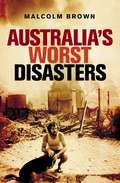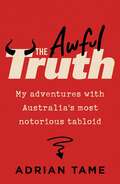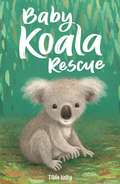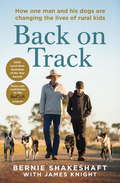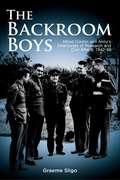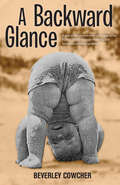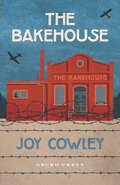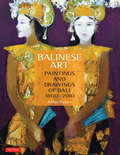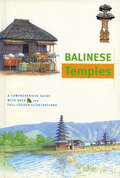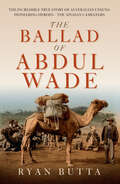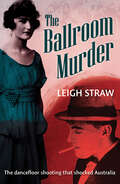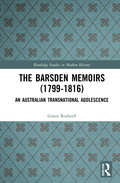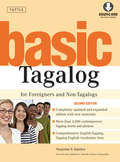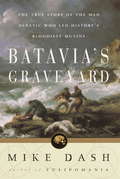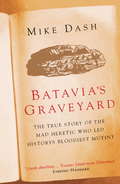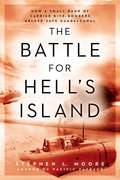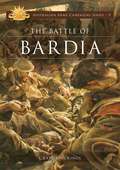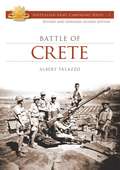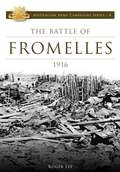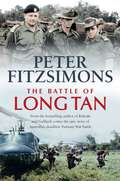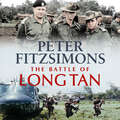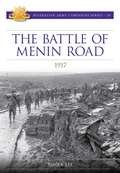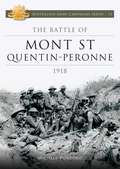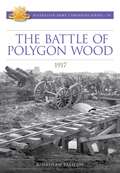- Table View
- List View
Australia's Worst Disasters
by Malcolm BrownGraphic accounts of Australia?s worst disasters ? historical as well as events of recent years.From the Ash Wednesday bushfires of 1983 to the implosion of the Royal Canberra Hospital in 1997, and from the shocking Granville railway crash in 1977 to the Sea King helicopter crash of 2005, Australia's history has been punctuated by incidents of disaster and tragedy that have shocked us all. Sometimes warning signs were not read (or were ignored); sometimes human error was to blame. These graphic and compelling accounts by veteran Sydney Morning Herald journalist Malcolm Brown and other award-winning journalists tell us far more than simply what happened - they provide unique insights into the impact of these events on the lives of innocent people. And, interspersed with stories of death and destruction, are heart-warming accounts of courage, grace and just plain good luck.
The Awful Truth: My adventures with Australia's most notorious tabloid
by Adrian TameBefore Fake News, there was the real Fake News. There was Truth. Hailed as &‘a fearless exposer of folly, vice and crime&’ when it first hit the streets in the 1890s, Truth was later condemned by a High Court Judge as &‘a wretched little paper, reeking of filth, injurious to the health of house servants and young girls&’. Much later it earned the nickname &‘The Old Whore of La Trobe Street&’. Truth was called many things but it was never boring. Adrian Tame knows that better than anyone as he worked for Truth for more than a decade as a reporter and news editor. In the years it was owned by the Murdoch family he worked alongside young Rupert as he cut his teeth on the shock horror scandals that graced the pages of Truth when it was selling a whopping 400,000 copies a week. Funny, often outrageous and always thoroughly entertaining, The Awful Truth is a rollercoaster ride through an colourful era of newspapers and larger-than-life reporters that we will never see the like of again.
Baby Animal Friends: Book 2 (Baby Animal Friends #2)
by Tilda KellyA tragic bush fire sparks a beautiful friendship between a young girl and a baby koala. Ruby is dreading changing schools as her autism makes it hard to befriend other kids. But when her dog finds a baby koala and her family agrees to foster it, Ruby quickly becomes the koala's best friend. Ruby loves quiet and routine, which makes her a perfect koala carer! A talented artist, she names the koala Pablo - after her favourite artist. Through looking after Pablo, Ruby befriends a neighbouring girl who loves painting as much as she does. Soon Pablo is well enough to move to a koala kindergarten. But is Ruby ready to move to her own new school?
Back on Track: How one man and his dogs are changing the lives of rural kids
by James Knight Bernie ShakeshaftAs a kid, Bernie Shakeshaft's mischievous and reckless behaviour led him to became known as the wild one of his devout Catholic family. It isn't surprising that his path led him to the Northern Territory, a place where people often go to either lose themselves or find themselves. Bernie, a searcher for his purpose in life, found himself.He had many jobs, firstly as a ringer on a cattle station owned by the Packer family, and later as a dingo trapper for the Parks and Wildlife Service. Throughout it all, he drank, he swore, he fought, and took chances with his own well-being. But, crucially, he also developed deep connections with the Indigenous people, and it was these connections that helped lay the foundations for what was to come. He worked for youth welfare organisations, and all the while he built up his knowledge about helping wayward youths, particularly those from Indigenous communities.Years later, Bernie was living in Armidale. He'd been visiting too many kids in prison and going to too many funerals. The usual methods weren't working so that reckless, mischievous kid inside him decided he could do better. He started a youth program called BackTrack, with three aims: To keep them alive, out of jail and chasing their hopes and dreams. For most, this was their last chance. Combining life skills, education, job preparedness with rural work, Bernie threw in one other factor: dogs! And it works. With the help of these working dogs, the lost boys (and girls) find their way back on track. These days, Backtrack youth tour the country competing in dog-jumping trials. Bernie and the BackTrack team are now supporting other communities in Lake Cargelligo, Broken Hill, Dubbo and Grafton and have forged a new beginning for over 1000 young people. This one man is making a huge difference.In Back on Track, bestselling author James Knight tells Bernie's story and the stories of those whose lives he has saved. It is a powerful reminder that we should never give up on our kids.'This fella Bernie, he's a good fella, a bit of a genius really. What a great story.' - Russell Crowe
The Backroom Boys: Alfred Conlon and Army's Directorate of Research and Civil Affairs,1942-46
by Graeme SligoThe Backroom Boys is the remarkable, but little known, story of how a varied group of talented intellectuals, drafted into the Australian Army in the dark days of 1942, provided high-level policy advice to Australia’s most senior soldier, General Blamey, and through him to the Government for the remainder of the war and beyond. This band of academics, lawyers and New Guinea patrol officers formed a unique military unit, the Directorate of Research and Civil Affairs, under the command of an eccentric and masterful string-puller, Alf Conlon. The Directorate has been depicted as a haven for underemployed poets or meddlesome soldier-politicians. Based on wide-ranging research, this book reveals a fuller and more fascinating picture. The fierce conflicts in the wartime bureaucracy between public servants and soldiers, in which the Directorate provided critical support to Blamey, went to the heart of military command, accountability and the profession of arms. The Directorate was a pioneer in developing approaches to military government in areas liberated by the combat troops, as demonstrated by the Australian Army in New Guinea, and Borneo in 1945-46. It is an issue of enduring importance. The Directorate established the Australian School of Pacific Administration, and had an important role in founding the Australian National University. Its influence extended into post war Australia. The Backroom Boys emphasises the personality of Colonel Alf Conlon, as well as the talented men and women he recruited. Above all, this book shows how, unexpectedly, the Australian Army fostered a group of men and women who made a lasting contribution to the development of Australia in the decades after the war.
A Backward Glance
by Beverley CowcherA beautiful and gentle story of a branch of the Mainland family, beginning with their early years in Australia. After establishing their roots in country Victoria, the family migrated to the farming community of Narrogin, in Western Australia, and finally lived in Dunsborough and Busselton, which were very different then from the towns we know today.A story of love, laughter, and sadness told with humour and self-deprecation as it journeys through a family's history. Full of unsung heroes and real people doing everything they can to make life wonderful for their families and children, while contributing as much as they could to the fabric of the communities they were living in.This is a story that will make you laugh and cry, and will leave you feeling better about the world.
The Bakehouse
by Joy CowleyBert wants nothing more than to be old enough to fight in the war—to handle weapons, defend his country, and have a life filled with adventure. Little does he know that the secrets and danger of war don't always stay at the front line, and that one boy's actions can change everything.
Balinese Art
by Adrian Vickers[Balinese Art is the first comprehensive survey of Balinese painting from its origins in the traditional Balinese village to its present position at the forefront of the high-priced Asian art scene.] Balinese art has been popular and widely collected around the world for many decades. In fact, the contemporary painter who commands the highest prices in Southeast Asia's hot art market is not Chinese but Bali-born Nyoman Masriadi (1973-)-and this book demonstrates that his work draws on a long and deeply-rooted tradition.[This book surveys the art scene in Bali for the past two hundred years. The author shows how Balinese painting has deep local roots and has followed its own distinctive trajectory, yet has been heavily influenced by outsiders.] Indian artistic and religious traditions were introduced to Bali over a thousand years ago through the prism of ancient Javanese culture. Balinese artists and craftsmen have also interacted with other Asian artists, particularly those of China, and later Western artists. From these sources, an aesthetic tradition developed that depicts stories from the ancient Indian epics as well as themes from Javanese mythology and the religious and communal life of the Balinese themselves.Starting with a discussion of the island's aesthetic traditions and how Balinese art should be viewed and understood, this book goes on to present pre-colonial painting traditions, some of which are still practiced in the village of Kamasan-the home of "classical" Balinese art. However, the main focus is the development of new styles starting in the 1930s and how these gradually evolved in response to the tourist industry that has come to dominate the island. [Balinese Art acquaints readers with the masterpieces and master artists of Bali, and the final chapter presents the most important artists who are active today and serves as an introduction to their work.]
Balinese Temples
by Julian Davison Bruce GranquistBali is an island with literally tens of thousands of temples, a proliferation of religious architecture probably not equaled anywhere else in the world.This book is intended as a general introduction to the architectural symbolism of the typical Balinese temple and the cosmological significance of its layout. The informative text is complemented by dozens of watercolor illustrations and will provide a useful guide to many of the temples that the reader is likely to visit during a stay on the island.
The Ballad of Abdul Wade: The Incredible True Story of Australia's unsung Pioneering Heroes - The Afghan Camelleers
by Ryan ButtaWhen Afghan entrepreneur Abdul Wade first brought his camel trains to the outback, he was hailed as a hero. Horses couldn't access many remote settlements, especially those stricken by flood or drought, and camel trains rode to the rescue time and time again.But with success came fierce opposition fuelled by prejudice. The camel was not even classed as an animal under Australian law, and, in a climate of colonial misinformation, hyperbole and fear, camel drivers like Wade were shown almost as little respect. Yet all the while, for those in need, the ships of the desert continued to appear on the outback horizon.After his interest was piqued by a nineteenth-century photo of a camel train in a country town, Ryan Butta found himself on the trail of Australia's earliest Afghan camel drivers. Separating the bulldust from the bush poetry, he reveals the breadth and depth of white Australian protectionism and prejudice. Told with flair and authority, this gritty alternative history defies the standard horse-powered folklore to reveal the untold debt this country owes to the humble dromedary, its drivers and those who brought them here.
The Ballroom Murder
by Leigh StrawIn August 1925, Audrey Jacob shot dead her former fiancé, Cyril Gidley, in full view of hundreds of guests at a charity ball in Perth's Government House. When she was arrested, she still held the gun in her hand. It was a open and shut case of wilful murder – that is until Jacob assigned prosecutor Arthur Haynes to her defence. His ability to play the press and the jury for sympathy would lead to a sensational result. Not only did Jacob escape the gallows, she was found not guilty of Gidley's murder. Straw, the author of a number of books about notable Australian female criminals, tells a story that is rich with first-hand newspaper accounts from the day.
The Barsden Memoirs: An Australian Transnational Adolescence (Routledge Studies in Modern History)
by Grant RodwellCovering the life of Josephus Henry Barsden from his birth in 1799 through his childhood to 16 years of age, the Barsden memoirs describe events from a Sussex smugglers’ inn, a convict ship to the colony of New South Wales, sealing and whaling expeditions to Van Diemen’s Land, and Barsden’s participation in a Tahitian civil war. The author assesses the value of memoirs, and of these memoirs in particular to students of history in respect to the transnational paradigm. He tests the historicity and veracity of their contents, and provides an engaging exegesis and graphical supplement of its contents. Of central importance is Barsden’s account of the Battle of Fe’i Pi, which was in many respects the Pacific’s equivalent to the contemporaneous Battle of Waterloo, such was its lasting impact on Pacific geopolitics. This was no ordinary childhood, and poses many questions about a transnational adolescent’s impact on major events. A fascinating read for scholars and students of Australian, Pacific, and British Colonial History, written with academic rigour but accessible to non-specialists.
Basic Tagalog
by Paraluman S. AspilleraBasic Tagalog takes a friendly and innovative approach, emphasizing the structure of the Tagalog language rather than just vocabulary. This user-friendly Tagalog textbook teaches more than 2,000 Tagalog words and expressions with over 500 being added for this new edition. These are spread throughout 44 lessons, the Appendices and the exercises as well as in the Tagalog-English and English-Tagalog vocabulary lists at back of the book. The added Tagalog vocabulary is meant to keep learners abreast of changes that have occurred in the language since the first edition of Basic Tagalog which was published. This edition has retained all the grammar lessons and the tried-and-tested teaching methodology developed b the author, Paraluman S. Aspillera, for the original version. Her method has proven to be extremely effective for tens of thousands of foreigners and non-Tagalogs who have used this book to lean to learn Tagalog, including many who have successfully learned to speak Tagalog, read Tagalog and write Tagalog through self-study on their own without a teacher. An audio CD has also been added to facilitate the correct pronunciation of Tagalog words and phrases. A succinct introduction to the language and a description of the character of Filipinos will hopefully provide learners with a better understanding of the language they are learning. The lessons in Basic Tagalog are intended for a three-month period of intensive study followed by another three months of applied oral communication. In six months (or about 250 hours), it is expected that an average learner should be able to speak, write and understand simple, everyday, conversational Tagalog as spoken by most Filipinos. Highlights of this book include: Over 2,000 Tagalog words and expressions. 44 lessons organized by organized for efficient language absorption. Extensive exercises and activities to reinforce the lessons. Vocabulary lists serve as comprehensive English-Tagalog and Tagalog-English dictionaries. Completely updated and expanded with new materials. Includes accompanying MP3 Audio CD. Using Basic Tagalog to study the Tagalog language will further encourage both non-Tagalogs and non-Filipinos to speak Tagalog better. Only then will they appreciate the individuality of the language that reflects the resilience and flexibility of Filipinos all around the world. In the end, such learning will improve daily interactions and communications between non-Filipinos and Filipinos-whether in business, education, tourism, social or civic endeavors.
Batavia's Graveyard
by Mike DashWhen the Dutch East Indiaman Batavia struck an uncharted reef off the new continent of Australia on her maiden voyage in 1629, 332 men, women and children were on board. While some headed off in a lifeboat to seek help, 250 of the survivors ended up on a tiny coral island less than half a mile long. A band of mutineers, whose motives were almost beyond comprehension, then started on a cold-blooded killing spree, leaving fewer than 80 people alive when the rescue boat arrived three months later. BATAVIA'S GRAVEYARD tells this strange story as a gripping narrative structured around three strong principal characters: Francisco Pelsaert, the cultivated but weak-willed captain; Jeronimus Cornelisz, a sinister apothecary with a terrifying personal philosophy influenced by Rosicrucianism who set himself up as the ruler of the island; and Wiebbe Hayes, the only survivor with the courage to fight Jeronimus's band. The background to these events, including the story of the Dutch East India Company, and the discovery of Australia, is richly drawn.
Batavia's Graveyard
by Mike DashThe true story of the mad heretic who led history's bloodiest mutiny - 'An adult version of LORD OF THE FLIES that is, moreover, entirely true' Evening StandardWhen the Dutch East Indiaman Batavia struck an uncharted reef off the new continent of Australia on her maiden voyage in 1629, 332 men, women and children were on board. While some headed off in a lifeboat to seek help, 250 of the survivors ended up on a tiny coral island less than half a mile long. A band of mutineers, whose motives were almost beyond comprehension, then started on a cold-blooded killing spree, leaving fewer than 80 people alive when the rescue boat arrived three months later. BATAVIA'S GRAVEYARD tells this strange story as a gripping narrative structured around three strong principal characters: Francisco Pelsaert, the cultivated but weak-willed captain; Jeronimus Cornelisz, a sinister apothecary with a terrifying personal philosophy influenced by Rosicrucianism who set himself up as the ruler of the island; and Wiebbe Hayes, the only survivor with the courage to fight Jeronimus's band. The background to these events, including the story of the Dutch East India Company, and the discovery of Australia, is richly drawn.
The Battle for Hell's Island
by Stephen L. MooreFrom the author of Pacific Payback comes the gripping true story of the Cactus Air Force and how this rugged crew of Dive-Bombers helped save Guadalcanal and won the war.November 1942: Japanese and American forces have been fighting for control of Guadalcanal, a small but pivotal island in Japan's expansion through the South Pacific. Both sides have endured months of grueling battle under the worst circumstances: hellish jungles, meager rations, and tropical diseases, which have taken a severe mental and physical toll on the combatants. The Japanese call Guadalcanal Jigoku no Jima--Hell's Island.Amid a seeming stalemate, a small group of U.S. Navy dive bombers are called upon to help determine the island's fate. The men have until recently been serving in their respective squadrons aboard the USS Lexington and the USS Yorktown, fighting in the thick of the Pacific War's aerial battles. Their skills have been honed to a fine edge, even as injury and death inexorably have depleted their ranks. When their carriers are lost, many of the men end up on the USS Enterprise. Battle damage to that carrier then forces them from their home at sea to operating from Henderson Field, a small dirt-and-gravel airstrip on Guadalcanal.With some Marine and Army Air Force planes, they help form the Cactus Air Force, a motley assemblage of fliers tasked with holding the line while making dangerous flights from their jungle airfield. Pounded by daily Japanese air assaults, nightly warship bombardments, and sniper attacks from the jungle, pilots and gunners rarely last more than a few weeks before succumbing to tropical ailments, injury, exhaustion, and death. But when the Japanese launch a final offensive to take the island once and for all, these dive-bomber jocks answer the call of duty--and try to perform miracles in turning back an enemy warship armada, a host of fighter planes, and a convoy of troop transports.A remarkable story of grit, guts, and heroism, The Battle for Hell's Island reveals how command of the South Pacific, and the outcome of the Pacific War, depended on control of a single dirt airstrip--and the small group of battle-weary aviators sent to protect it with their lives.
The Battle for Hell's Island: How a Small Band of Carrier Dive-Bombers Helped Save Guadalcanal
by Stephen L. MooreFrom the author of Pacific Payback comes the gripping true story of the Cactus Air Force and how this rugged crew of Dive-Bombers helped save Guadalcanal and won the war.November 1942: Japanese and American forces have been fighting for control of Guadalcanal, a small but pivotal island in Japan's expansion through the South Pacific. Both sides have endured months of grueling battle under the worst circumstances: hellish jungles, meager rations, and tropical diseases, which have taken a severe mental and physical toll on the combatants. The Japanese call Guadalcanal Jigoku no Jima--Hell's Island.Amid a seeming stalemate, a small group of U.S. Navy dive bombers are called upon to help determine the island's fate. The men have until recently been serving in their respective squadrons aboard the USS Lexington and the USS Yorktown, fighting in the thick of the Pacific War's aerial battles. Their skills have been honed to a fine edge, even as injury and death inexorably have depleted their ranks. When their carriers are lost, many of the men end up on the USS Enterprise. Battle damage to that carrier then forces them from their home at sea to operating from Henderson Field, a small dirt-and-gravel airstrip on Guadalcanal.With some Marine and Army Air Force planes, they help form the Cactus Air Force, a motley assemblage of fliers tasked with holding the line while making dangerous flights from their jungle airfield. Pounded by daily Japanese air assaults, nightly warship bombardments, and sniper attacks from the jungle, pilots and gunners rarely last more than a few weeks before succumbing to tropical ailments, injury, exhaustion, and death. But when the Japanese launch a final offensive to take the island once and for all, these dive-bomber jocks answer the call of duty--and try to perform miracles in turning back an enemy warship armada, a host of fighter planes, and a convoy of troop transports.A remarkable story of grit, guts, and heroism, The Battle for Hell's Island reveals how command of the South Pacific, and the outcome of the Pacific War, depended on control of a single dirt airstrip--and the small group of battle-weary aviators sent to protect it with their lives.
The Battle of Bardia (Australian Army Campaigns #9)
by Craig StockingsOn the morning of 3 January 1941, Australians of the 6th Division led an assault against the Italian colonial fortress village of Bardia in Libya, not far from the Egyptian-Libyan frontier. The ensuing battle was the second of the First Libyan Campaign, but the first battle of the Second World War planned and fought predominantly by Australians. The fortress fell to the attackers a little over two days after the attack began, in what could only be described as a remarkable victory. At a cost of 130 killed and 326 wounded, the 6th Division captured around 40,000 Italian prisoners and very large quantities of military stores and equipment. The victory was heralded at the time in Australia as one of the greatest military achievements of that nation's military history. Quite soon afterwards, however, overshadowed perhaps by Rommel's subsequent desert advances, the tragedy in Greece, and the war in the Pacific, Bardia slipped from the public mind. Very few Australians today have heard of the battle. This book attempts to bring Bardia back into the light.
The Battle of Crete (Australian Army Campaigns #1)
by Albert PalazzoBetween 20 May and 1 June 1941 the Second World War came to the Greek island of Crete. The Commonwealth defenders consisted of Australian, New Zealand and British refugees from the doomed Greek Campaign who had not recovered from defeat.
The Battle of Fromelles 1916: A Case Study Of An Evolving Skill (Australian Army Campaigns #8)
by Roger LeeThe Battle of Fromelles remains the single bloodiest day in terms of soldiers killed, wounded or missing, in Australia's military history. Remains of soldiers were recently discovered in mass graves in northern France and the final soldier will be laid to rest when a new cemetery officially opens on 19th July, 2010 - the 94th anniversary of the battle.
The Battle of Long Tan
by Peter FitzSimonsFrom the bestselling author of Kokoda and Gallipoli comes the epic story of Australia's deadliest Vietnam War battle.4.31 pm: Enemy [on] left flank. Could be serious.5.01 pm: Enemy ... penetrating both flanks and to north and south.5.02: Running short of ammo. Require drop through trees.It was the afternoon of 18 August 1966, hot, humid with grey monsoonal skies. D Company, 6RAR were four kilometres east of their Nui Dat base, on patrol in a rubber plantation not far from the abandoned village of Long Tan. A day after their base had suffered a mortar strike, they were looking for Viet Cong soldiers. Then - just when they were least expecting - they found them. Under withering fire, some Diggers perished, some were grievously wounded, the rest fought on, as they remained under sustained attack.For hours these men fought for their lives against the enemy onslaught. The skies opened and the rain fell as ferocious mortar and automatic fire pinned them down. Snipers shot at close quarters from the trees that surrounded them. The Aussie, Kiwi and Yankee artillery batteries knew it was up to them but, outnumbered and running out of ammunition they fired, loaded, fired as Viet Cong and North Vietnamese Army forces just kept coming. And coming.Their only hope was if Armoured Personnel Carriers (APCs) could reach them before they were wiped out. The APCs did their best but low cloud and thunderstorms meant air support was stalled. A daring helicopter resupply mission was suggested but who would want to fly that? The odds against this small force were monumental...By far the deadliest battle for Australian forces in Vietnam, the Battle of Long Tan has a proud place in the annals of Australian military history - and every ANZAC who fought there could hold his head high.Peter FitzSimons, Australia's greatest storyteller, tells the real story of this classic battle. He reveals the horror, the bravery, the wins and the losses that faced our soldiers. He brings to life the personal stories of the men who fought, the events leading up to that memorable battle and the long war that followed, and the political decisions made in the halls of power that sealed their fates. The Battle of Long Tan is an engrossing and powerful history that shows the costs of war never end.
The Battle of Long Tan
by Peter FitzSimonsFrom the bestselling author of Kokoda and Gallipoli comes the epic story of Australia's deadliest Vietnam War battle.4.31 pm: Enemy [on] left flank. Could be serious.5.01 pm: Enemy ... penetrating both flanks and to north and south.5.02: Running short of ammo. Require drop through trees.It was the afternoon of 18 August 1966, hot, humid with grey monsoonal skies. D Company, 6RAR were four kilometres east of their Nui Dat base, on patrol in a rubber plantation not far from the abandoned village of Long Tan. A day after their base had suffered a mortar strike, they were looking for Viet Cong soldiers. Then - just when they were least expecting - they found them. Under withering fire, some Diggers perished, some were grievously wounded, the rest fought on, as they remained under sustained attack.For hours these men fought for their lives against the enemy onslaught. The skies opened and the rain fell as ferocious mortar and automatic fire pinned them down. Snipers shot at close quarters from the trees that surrounded them. The Aussie, Kiwi and Yankee artillery batteries knew it was up to them but, outnumbered and running out of ammunition they fired, loaded, fired as Viet Cong and North Vietnamese Army forces just kept coming. And coming.Their only hope was if Armoured Personnel Carriers (APCs) could reach them before they were wiped out. The APCs did their best but low cloud and thunderstorms meant air support was stalled. A daring helicopter resupply mission was suggested but who would want to fly that? The odds against this small force were monumental...By far the deadliest battle for Australian forces in Vietnam, the Battle of Long Tan has a proud place in the annals of Australian military history - and every ANZAC who fought there could hold his head high.Peter FitzSimons, Australia's greatest storyteller, tells the real story of this classic battle. He reveals the horror, the bravery, the wins and the losses that faced our soldiers. He brings to life the personal stories of the men who fought, the events leading up to that memorable battle and the long war that followed, and the political decisions made in the halls of power that sealed their fates. The Battle of Long Tan is an engrossing and powerful history that shows the costs of war never end.
The Battle of Menin Road 1917 (Australian Army Campaigns #20)
by Roger LeeThe Passchendaele Campaign of 1917 is associated with images of slimy, oozing mud: mud deep enough and glutinous enough to drown men, horses and equipment, mud so pervasive that it, rather than the enemy, defeated the British Army’s only major campaign in Belgium. While these images are certainly true for the opening and final months of the campaign, mud was not he defining experience for the infantry of the Australian First and Second Divisions when, for the first time in history, two Australian Divisions fought a battle side by side in the Battle of Menin Road. For them, the defining experience was a well planned, well-conducted attack that saw all the objectives achieved in very short time. Menin Road was the third of the series of battles that together made up the Passchendaele (Third Ypres) Campaign. Intended to capture the high ground of the Gheluvelt Plateau east of Ypres to protect the right flank of the British Army advancing to its north, it was a difficult assignment. Earlier British attempts to clear the Plateau had been repulsed with heavy losses. With overwhelming artillery and air support, sound preparation and with limited objectives, the attack on 20 September surpassed all expectations. It was a classic example of how well-prepared and well-supported infantry could take and hold ground. However, as is explained in the book, it was also a classic example of why this operational method was too slow and would never win the war on the Western Front.
The Battle of Mont St Quentin Peronne 1918: The Battle of Mont St Quentin-Peronne 1918 (Australian Army Campaigns #11)
by Michele BomfordThe Battle of Mont St Quentin-Peronne 1918 explores the relationship between myth and history and the significance of the Anzac legend. It analyses the forces that drove the diggers forward even when they had reached the limits of their endurance. The Battle of Mont St Quentin-Peronne represents the Australian Corps at its very best, its diggers fighting for peace and satisfied that, `whatever might lie ahead, at least everything was right behind them'.
The Battle of Polygon Wood 1917 (Australian Army Campaigns #19)
by Jonathan PasslowBuoyed by the success of the 1st and 2nd Australian divisions in the Battle of Menin Road, the men of the 4th and 5th Australian divisions filed into the front line ready for the next phase of the battle. Ahead of them lay the blackened remnants of Polygon Wood, a desolate expanse of splintered stumps shattered by the devastating shellfire. The view across no man’s land revealed lines of German barbed wire and a criss-cross of heavily defended trenches. Here and there the Australians could also see solid concrete pillboxes dotted around the landscape. In the centre of the battlefield sat a huge man-made mound of earth — the Butte. Once the stop-butte for an old artillery range, this dominating feature was fortified with machine-guns, laced with barbed wire and riddled with tunnels and dugouts. The Battle of Polygon Wood was the second phase in the British forces’ advance on Passchendaele. Success at Polygon Wood would place Broodseinde Ridge within the Second Army’s reach. But the entire operation was almost blindsided by a German counter-attack on the eve of the battle. The critical situation on the Anzac Corps right was only saved by Pompey Elliott’s 15th Brigade whose desperate efforts to contain the German attack and seize the Second Army’s objectives turned a ‘fine success’ into a ‘splendid victory’. But, as author Jonathan Passlow describes in Polygon Wood 1917, this was a victory that was by no means assured and in which luck would play its part.
